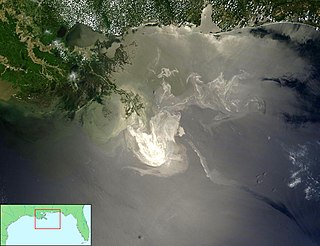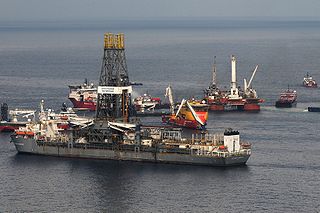
A containment dome is a component of the system designed to contain the underwater blowout of an oil well such as occurred with the Macondo Well blowout from the Deepwater Horizon oil spill. This portion of the system is designed as a vacuum to suck up the products being expelled from a blowout and deliver those products to the containment system housed on the vessel moored above the blowout. Superior Energy Services is constructing this device to be used by Shell Oil Company on the barge Arctic Challenger as their "fourth line of defense" against a blowout in the Arctic drilling regions in the Chukchi Sea and Beaufort Sea.

A blowout is the uncontrolled release of crude oil and/or natural gas from an oil well or gas well after pressure control systems have failed. Modern wells have blowout preventers intended to prevent such an occurrence. An accidental spark during a blowout can lead to a catastrophic oil or gas fire.

A blowout preventer (BOP) is a specialized valve or similar mechanical device, used to seal, control and monitor oil and gas wells to prevent blowouts, the uncontrolled release of crude oil or natural gas from a well. They are usually installed in stacks of other valves.

Deepwater Horizon was an ultra-deepwater, dynamically positioned, semi-submersible offshore drilling rig owned by Transocean and operated by BP. On 20 April 2010, while drilling at the Macondo Prospect, a blowout caused an explosion on the rig that killed 11 crewmen and ignited a fireball visible from 40 miles (64 km) away. The fire was inextinguishable and, two days later, on 22 April, the Horizon sank, leaving the well gushing at the seabed and causing the largest marine oil spill in history.

Q4000 is a multi-purpose oil field construction and intervention vessel ordered in 1999 by Cal Dive International, and was built at the Keppel AmFELS shipyard in Brownsville, Texas for $180 million. She was delivered in 2002 and operates under the flag of the United States. She is operated by Helix Energy Solutions Group. The original Q4000 concept was conceived and is owned by SPD/McClure. The design was later modified by Bennett Offshore, which was selected to develop both the basic and detailed design.

The Deepwater Horizon oil spill was an industrial disaster which began on April 20, 2010, off the coast of the United States in the Gulf of Mexico on the BP-operated Macondo Prospect, considered the largest marine oil spill in the history of the petroleum industry and estimated to be 8 to 31 percent larger in volume than the previous largest, the Ixtoc I oil spill, also in the Gulf of Mexico. Caused in the aftermath of a blowout and explosion on the Deepwater Horizon oil platform, the United States federal government estimated the total discharge at 4.9 MMbbl. After several failed efforts to contain the flow, the well was declared sealed on 19 September 2010. Reports in early 2012 indicated that the well site was still leaking. The Deepwater Horizon oil spill is regarded as one of the largest environmental disasters in world history.
The Macondo Prospect is an oil and gas prospect in the United States Exclusive Economic Zone of the Gulf of Mexico, off the coast of Louisiana. The prospect was the site of the Deepwater Horizon drilling rig explosion in April 2010 that led to a major oil spill in the region from the first exploration well, named itself MC252-1, which had been designed to investigate the existence of the prospect.

The Deepwater Horizon drilling rig explosion was an April 20, 2010 explosion and subsequent fire on the Deepwater Horizon semi-submersible mobile offshore drilling unit, which was owned and operated by Transocean and drilling for BP in the Macondo Prospect oil field about 40 miles (64 km) southeast off the Louisiana coast. The explosion and subsequent fire resulted in the sinking of the Deepwater Horizon and the deaths of 11 workers; 17 others were injured. The same blowout that caused the explosion also caused an oil well fire and a massive offshore oil spill in the Gulf of Mexico, considered the largest accidental marine oil spill in the world, and the largest environmental disaster in United States history.

The Bureau of Safety and Environmental Enforcement is an agency under the United States Department of the Interior. Established in 2011, BSEE is the lead agency in charge of improving safety and ensuring environmental protection relating to the offshore energy industry, mainly natural gas and oil, on the United States Outer Continental Shelf (OCS). The agency exercises the safety and environmental enforcement functions formerly under the Minerals Management Service including the authority to inspect, investigate, summon witnesses and produce evidence, levy penalties, cancel or suspend activities, and oversee safety, response, and removal preparedness.
The following is a timeline of the Deepwater Horizon oil spill. It was a massive oil spill in the Gulf of Mexico, the largest offshore spill in U.S. history. It was a result of the well blowout that began with the Deepwater Horizon drilling rig explosion on April 20, 2010.

Discoverer Enterprise is a fifth generation deepwater double hulled dynamically positioned drillship owned and operated by Transocean Offshore Deepwater Drilling Inc., capable of operating in moderate environments and water depths up to 3,049 m (10,000 ft) using an 18.75 in (47.6 cm), 15,000 psi blowout preventer (BOP), and a 21 in (53 cm) outside diameter (OD) marine riser. From 1998 to 2005 the vessel was Panama-flagged and currently flies the flag of convenience of the Marshall Islands.

Offshore oil spill prevention and response is the study and practice of reducing the number of offshore incidents that release oil or hazardous substances into the environment and limiting the amount released during those incidents.
On May 30, 2010 a 6-month moratorium on all deepwater offshore drilling on the Outer Continental Shelf was declared by U.S. Secretary of the Interior Ken Salazar. The limitation was in response to the Deepwater Horizon oil spill which occurred in the Gulf of Mexico.
Following is a timeline of the Deepwater Horizon oil spill for June 2010.
Following is a timeline of the Deepwater Horizon oil spill for July 2010.
Following is a Timeline of the Deepwater Horizon oil spill for May 2010.
The Helix fast-response system (HFRS) is a deep-sea oil spill response plan licensed by HWCG LLC, a consortium of 16 independent oil companies, to respond to subsea well incidents. Helix Energy Solutions Group designed the Helix fast-response system based on techniques used to contain the 2010 Gulf of Mexico oil spill. On February 28, 2011 the drilling moratorium imposed as a result of the spill ended when the United States Department of the Interior approved the first drilling permit based on the availability of the HFRS to offshore oil companies.

Arctic Challenger is a barge which has been converted by Superior Energy Services for use in the Arctic drilling operations of Shell Oil Company. This barge is designed to function as a "novel engineering solution" which they refer to as an Arctic Containment System to respond should a blowout event occur at drilling sites in the Beaufort or Chukchi Seas. According to testimony provided to Senator Mark Begich on 11 October 2012, Coast Guard Rear Admiral Thomas Ostebo said the certification for the Shell spill barge Arctic Challenger to operate in Alaska was given on the 10th of October at the Bellingham, Washington shipyard where it was constructed. Ostebo is commander of the Coast Guard's 17th district, which covers Alaska.
The Deepwater Horizon investigation included several investigations and commissions, among others reports by National Incident Commander Thad Allen, United States Coast Guard, National Commission on the BP Deepwater Horizon Oil Spill and Offshore Drilling, Bureau of Ocean Energy Management, Regulation and Enforcement, National Academy of Engineering, National Research Council, Government Accountability Office, National Oil Spill Commission, and Chemical Safety and Hazard Investigation Board.
Marine Well Containment Company (MWCC) provides well containment equipment and technology in the deepwater U.S. Gulf of Mexico for use after blowouts. It is based in Houston, Texas. MWCC members are major companies in the petroleum industry that drill wells in the Gulf of Mexico including: BP, Shell Oil, ExxonMobil, Chevron Corporation and ConocoPhillips.










